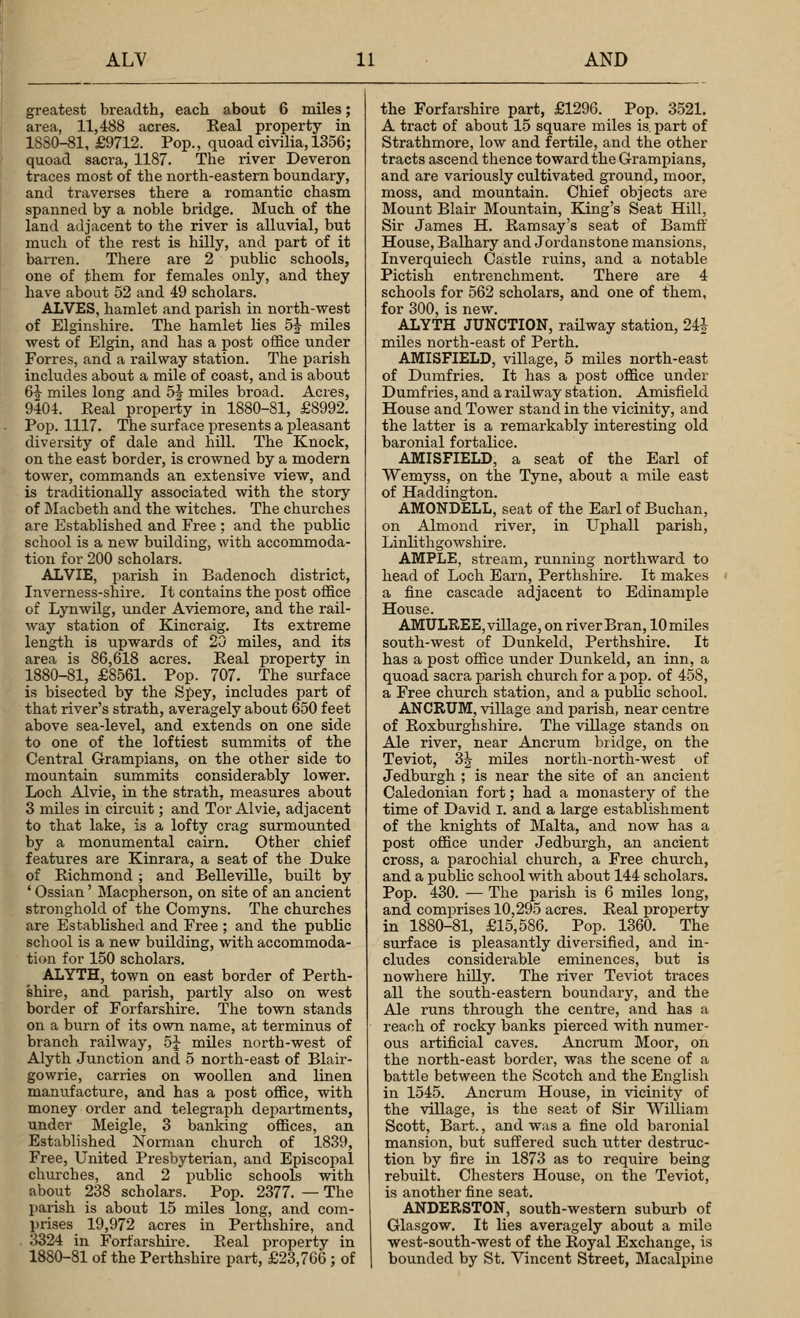ALVES, hamlet and parish in north-west of Elginshire. The hamlet lies 5J miles west of Elgin, and has a post office under Forres, and a railway station. The parish includes about a mile of coast, and is about 6J miles long and 5J miles broad. Acres, 9404. Real property in 1880-81, 8992. Pop. 1117. The surface presents a pleasant diversity of dale and hill. The Knock, on the east border, is crowned by a modern tower, commands an extensive view, and is traditionally associated with the story of Macbeth and the witches. The churches are Established and Free ; and the public school is a new building, with accommodation for 200 scholars.
ALVIE, parish in Badenoch district, Inverness-shire. It contains the post office of Lynwilg, under Aviemore, and the rail-way station of Kincraig. Its extreme length is upwards of 20 miles, and its area is 86,618 acres. Keal property in 1880-81, 8561. Pop. 707. The surface is bisected by the Spey, includes part of that river's strath, averagely about 650 feet above sea-level, and extends on one side to one of the loftiest summits of the Central Grampians, on the other side to mountain summits considerably lower. Loch Alvie, in the strath, measures about 3 miles in circuit ; and Tor Alvie, adjacent to that lake, is a lofty crag surmounted by a monumental cairn. Other chief features are Kinrara, a seat of the Duke of Richmond ; and Belleville, built by ' Ossian ' Macpherson, on site of an ancient stronghold of the Comyns. The churches are Established and Free ; and the public school is a new building, with accommodation for 150 scholars.
ALYTH, town on east border of Perthshire, and parish, partly also on west border of Forfarshire. The town stands on a burn of its own name, at terminus of branch railway, 5J miles north-west of Alyth Junction and 5 north-east of Blairgowrie, carries on woollen and linen manufacture, and has a post office, with money order and telegraph departments, under Meigle, 3 banking offices, an Established Norman church of 1839, Free, United Presbyterian, and Episcopal churches, and 2 public schools with about 238 scholars. Pop. 2377. The parish is about 15 miles long, and com-prises 19,972 acres in Perthshire, and 3324 in Forfarshire. Real property in 1880-81 of the Perthshire part, 23,766 ; of the Forfarshire part, 1296. Pop. 3521. A tract of about 15 square miles is. part of Strathmore, low and fertile, and the other tracts ascend thence to ward the Grampians, and are variously cultivated ground, moor, moss, and mountain. Chief objects are Mount Blair Mountain, King's Seat Hill, Sir James H. Ramsay's seat of Bamff House, Balhary and Jordanstone mansions, Inverquiech Castle ruins, and a notable Pictish entrenchment. There are 4 schools for 562 scholars, and one of them, for 300, is new.
ALYTH JUNCTION, railway station, 24J miles north-east of Perth.
AMISFIELD, village, 5 miles north-east of Dumfries. It has a post office under Dumfries, and a railway station. Amisfield House and Tower stand in the vicinity, and the latter is a remarkably interesting old baronial fortalice.
AMISFIELD, a seat of the Earl of Wemyss, on the Tyne, about a mile east of Haddington.
AMONDELL, seat of the Earl of Buchan, on Almond river, in Uphall parish, Linlithgowshire.
AMPLE, stream, running northward to head of Loch Earn, Perthshire. It makes a fine cascade adjacent to Edinample House.
AMULREE, village, on river Bran, 10 miles south-west of Dunkeld, Perthshire. It has a post office under Dunkeld, an inn, a quoad sacra parish church for a pop. of 458, a Free church station, and a public school.
ANCRUM, village and parish, near centre of Roxburghshire. The village stands on Ale river, near Ancrum bridge, on the Teviot, 3J miles north-north-west ^ of Jedburgh ; is near the site of an ancient Caledonian fort ; had a monastery of the time of David I. and a large establishment of the knights of Malta, and now has a post office under Jedburgh, an ancient cross, a parochial church, a Free church, and a public school with about 144 scholars. Pop. 430. The parish is 6 miles long, and comprises 10,295 acres. Real property in 1880-81, 15,586. Pop. 1360. The surface is pleasantly diversified, and includes considerable eminences, but is nowhere hilly. The river Teviot traces all the south-eastern boundary, and the Ale runs through the centre, and has a reach of rocky banks pierced with numerous artificial caves. Ancrum Moor, on the north-east border, was the scene of a battle between the Scotch and the English in 1545. Ancrum House, in vicinity of the village, is the seat of Sir William Scott, Bart. , and was a fine old baronial mansion, but suffered such utter destruction by fire in 1873 as to require being rebuilt. Chesters House, on the Teviot, is another fine seat.
ANDERSTON, south-western suburb of Glasgow. It lies averagely about a mile west-south-west of the Royal Exchange, is bounded by St. Vincent Street, Macalpine Street, the river Clyde, and Finnieston ; extends about 3} furlongs from north to south, and about 5 furlongs from east to west ; embraces an important section of the harbour; contains many factories, foundries, and other industrial establishments, and presents for the most part a dingy appearance, very different from that of adjacent places. It was originally a weavers' village, founded in 1725; it became a considerable town, with the status of a burgh of barony ; it was long separated from the outskirts of Glasgow by a wide rural tract, and it was eventually overtaken and engirt by the city's westward extension, and included in Glasgow municipal burgh. It has tramway communication with all parts of the city, and it contains several ornamental churches, a number of other churches, and a very large public school. Pop. of Anderston quoad sacra parish, 7273; of registration district, 38,753.

